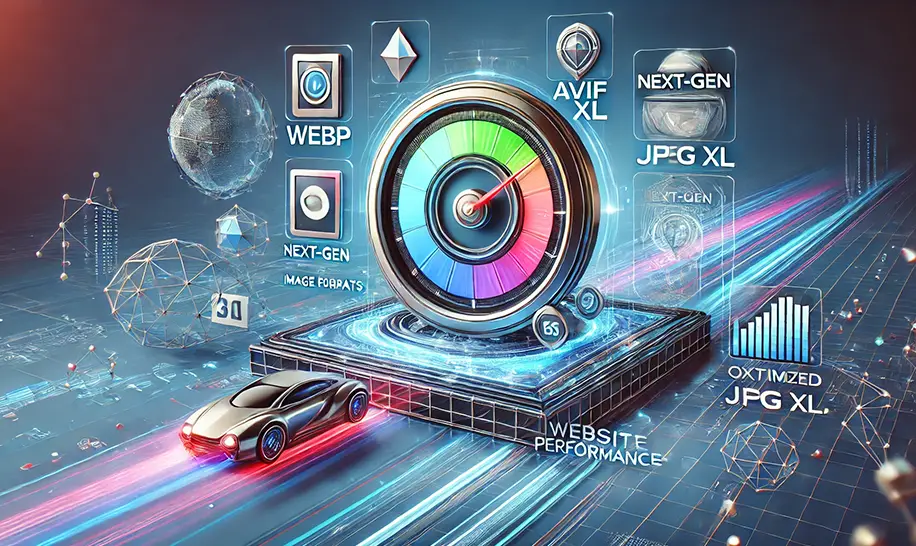
Boost Your Websites Performance with Next-Gen Image Formats.
In today's fast-paced digital world, improving your website's speed and overall performance is crucial. One of the most effective ways to do this is by using next-generation image formats. These formats help reduce file sizes, increase load speed, and enhance user experience. Whether you are a website owner, a digital marketer, or a web developer, optimizing images is key to staying competitive. In this article, we will explore why next-gen image formats matter and how they can elevate your website's SEO and usability.
Why Website Performance Matters in SEO and UX
Before diving into image formats, it's important to understand why website performance is critical. Google has emphasized site speed as a ranking factor. Slow-loading websites not only frustrate users but also lead to higher bounce rates. In contrast, a fast-loading site improves search engine rankings, boosts conversion rates, and offers a smooth user experience (UX).
Several factors contribute to website performance, but images typically account for the majority of a webpage's weight. Therefore, optimizing images using modern formats is a practical step to improve loading times and overall performance.
What Are Next-Gen Image Formats?
Next-gen image formats are advanced file types designed to replace older formats like JPEG and PNG. They deliver high-quality visuals at significantly smaller file sizes. Popular next-generation formats include:
- WebP
- AVIF
- JPEG XL
These formats offer superior compression without sacrificing image clarity. By using next-gen images, websites can reduce page load times, which is essential for SEO performance and user engagement.
WebP Format
WebP is developed by Google and is supported by most modern browsers. It offers both lossy and lossless compression. Compared to traditional formats like JPEG and PNG, WebP images can be up to 30% smaller in size. WebP also supports transparency and animation, making it versatile for various web applications.
AVIF Format
AVIF (AV1 Image File Format) provides even better compression than WebP. It is based on the AV1 video codec and is gaining popularity for its superior performance. AVIF files can be around 50% smaller than JPEGs, with minimal loss of visual quality. However, AVIF support is still rolling out across all browsers.
JPEG XL Format
JPEG XL is designed to be a potential successor to the traditional JPEG format. It offers improved compression efficiency and faster decoding. JPEG XL is backward compatible, meaning it can easily integrate into existing workflows.
SEO Benefits of Using Next-Gen Image Formats
Using modern image formats is more than a technical upgrade—it directly impacts your search engine optimization (SEO). Here's how:
1. Faster Page Load Speed
One of Google's core ranking factors is page speed. By reducing image file sizes through next-gen formats, you can significantly enhance loading times, leading to better rankings in search engine results pages (SERPs).
2. Improved Core Web Vitals
Google's Core Web Vitals focus on metrics like Largest Contentful Paint (LCP) and Cumulative Layout Shift (CLS). Optimized images help improve LCP by speeding up the loading of large images, which contributes to higher user satisfaction and improved SEO performance.
3. Better Mobile Performance
Mobile users are more likely to abandon slow-loading pages. Since next-gen images are lighter, they ensure faster load times on mobile devices, contributing to a responsive and mobile-friendly site experience.
4. Reduced Bandwidth Usage
With smaller image files, you also lower bandwidth usage. This is crucial for users in regions with slower internet connections and helps reduce hosting costs, making your website more efficient overall.
User Experience (UX) Improvements
A fast website naturally creates a better user experience. Visitors are more likely to engage with your content and navigate multiple pages when the site loads quickly. Additionally, next-gen formats preserve image quality, so visuals look crisp and professional.
Imagine an online store where every product image loads instantly. This positive experience not only enhances customer satisfaction but also encourages conversions, whether that's making a purchase, filling out a form, or subscribing to a newsletter.
How to Implement Next-Gen Image Formats
To take full advantage of these modern formats, follow these simple steps:
1. Audit Your Existing Images
Use tools like Google PageSpeed Insights or Lighthouse to identify large images slowing down your site. These tools often recommend converting to next-gen formats.
2. Convert Images
You can use image conversion tools such as:
- Squoosh (by Google): https://squoosh.app
- ImageMagick: https://imagemagick.org
- Online-Convert.com: https://www.online-convert.com
These tools let you easily convert JPEGs or PNGs to WebP, AVIF, or JPEG XL formats.
3. Update HTML and CSS
After converting images, update your website's HTML or CSS files to serve the new formats. For example, the <picture> tag allows you to specify multiple image formats for browser compatibility.
4. Implement Lazy Loading
To further improve performance, use lazy loading. This technique delays loading images until they appear in the user's viewport. It reduces initial load times and improves perceived performance.
5. Use a Content Delivery Network (CDN)
Many CDNs now automatically optimize and serve next-gen image formats depending on the visitor's browser capabilities. Services like Cloudflare, Akamai, and Fastly offer image optimization solutions to enhance speed and efficiency.
Final Thoughts: Stay Ahead with Next-Gen Images
Switching to next-generation image formats is one of the easiest yet most effective ways to boost your website's performance. It supports both SEO efforts and user experience improvements. Whether you're running a blog, an eCommerce store, or a corporate website, integrating WebP, AVIF, or JPEG XL images will make your site faster and more competitive.
By optimizing your images today, you position your website for better search visibility, higher engagement, and improved conversion rates tomorrow. Don't let outdated formats slow you down—embrace modern image technology and reap the benefits.



